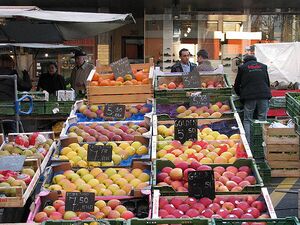Category:Swiss recipes


In this category you will find recipes that have Swiss roots. Swiss cuisine is unique in its many regional influences from its neighbours, including Italy, France, and Germany. However, the Swiss also have their own unique dishes. Switzerland was for a long time a country of farmers, so their specialties involve potatoes and cheese and also some more exquisite foods such as chocolate. The four linguistic regions of Switzerland (German, French, Italian and Romansh (spoken almost uniquely in Graubünden Canton)) each provide some special dishes. Most of which can be found throughout Switzerland.
Foods often associated with Switzerland include cheese and chocolate. Swiss cheeses, in particular Emmental cheese, Gruyère, Vacherin, and Appenzeller, are famous Swiss products. The most popular cheese dishes are fondue and Raclette. Both these dishes were originally regional dishes, but were popularised by the Swiss Cheese Union to boost sales of cheese.
Rösti is a popular potato dish that is eaten all over Switzerland. It was originally a breakfast food, but this has been replaced by müsli, which is commonly eaten for breakfast. For breakfast and dinner many Swiss enjoy sliced bread with butter and jam. There is a wide variety of bread rolls available in Switzerland. Bread and cheese is a popular dish for dinner. Tarts and quiches are also traditional Swiss dishes. Tarts in particular are made with all sorts of toppings, from sweet apple to onion. Cervelat or cervelas is considered the national sausage, and is popular all over Switzerland.
There are a great number of regional dishes in Switzerland. One example is Zürcher Geschnetzeltes — thin strips of veal with mushrooms in a cream sauce served with rösti. Italian cuisine is popular in contemporary Switzerland, particularly pasta and pizza.
In the Italian speaking part of Switzerland, the Ticino area, one will find a type of restaurant unique to the region. The Grotto is a rustic eatery, offering traditional food ranging from pasta to home made meat specialties. Popular dishes are Luganighe and Luganighetta, types of artisan sausages. Authentic grottoes are old wine caves re-functioned into restaurants.
We also have a wealth of information on Swiss cheeses.
AOC ingredients
AOC stands for ‘Appellation d’Origine Contrôlée’ which translates as ‘controlled name of origin’. AOC is an official quality typically reserved for products which are rooted in a region that gives them a specific and unique flavour. They guarantee the authenticity of products developed through traditional skills. An AOC product is fully produced in its region of origin. In general, AOC products bear the name of the geographical region to which they belong and it is therefore important that the name is used only for products that meet the conditions. The following Swiss ingredients are those which are registered as AOC.
IGP ingredients
IGP stands for ‘Indication Géographique Protégée’ which translates as ‘controlled name of origin’. IGP is an official Swiss quality typically reserved for products which are rooted in a region that gives them a specific and unique flavour. They guarantee the authenticity of products developed through traditional skills. With IGP at least one stage of production must take place in its region of origin. Meat sausage IGP can come from a farm located outside its area of origin. It is above all the know-how that gives it its identity. In general, IGP products bear the name of the geographical region to which they belong and it is therefore important that the name is used only for products that meet the conditions. The following Swiss ingredients are those which are registered as IGP.
SWISS RECIPES
Pages in category ‘Swiss recipes’
The following 25 pages are in this category, out of 25 total.